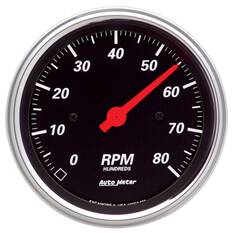The Benefits of Setting Up a Tachometer in Your Automobile
The Benefits of Setting Up a Tachometer in Your Automobile
Blog Article
The Value of a Tachometer in Monitoring Engine Rate and Performance in Automotive Applications
In the realm of automobile engineering, the tachometer stands as an essential tool in the driver's arsenal, supplying a straight home window right into the internal functions of a lorry's engine. Past its feature as a plain scale of changes per min (RPM), the tachometer offers as a crucial tool for enthusiasts and professionals alike, providing real-time insights into engine performance and health.
Importance of Monitoring Engine RPM
Monitoring engine RPM, or revolutions per minute, is a critical aspect of automotive upkeep and efficiency examination. Engine RPM straight correlates with the speed at which the engine's crankshaft rotates, showing just how swiftly the engine is running - tachometer. By keeping an eye on RPM, auto mechanics can examine the health and wellness of the engine, spot potential concerns, and fine-tune efficiency. An irregular RPM reading might signify issues such as engine misfires, malfunctioning stimulate plugs, or issues with the gas shipment system. Regularly high RPM analyses could show aggressive driving practices or the need for a greater gear change to boost gas performance.
In addition, checking engine RPM is necessary for efficiency evaluation in auto racing and high-performance automobiles. In recap, keeping an eye on engine RPM is not only important for finding problems but likewise for optimizing engine efficiency in various vehicle applications.

Advantages of Real-Time Information
In vehicle applications, real-time data plays a crucial duty in supplying instantaneous understandings right into the efficiency and problem of the automobile. By continually monitoring various parameters such as engine rate, temperature level, gas intake, and more, real-time data offers numerous advantages that add to boosted performance and safety and security when traveling.
Furthermore, real-time information assists in performance optimization by supplying immediate responses on driving practices and engine effectiveness. Drivers can readjust their behavior in real-time based on this details to achieve far better fuel economic climate and prolong the life-span of their automobile.

Moreover, real-time data plays an essential function in modern-day automobile diagnostics, making it possible for service technicians to quickly identify and resolve breakdowns. This results in lowered downtime, lower upkeep costs, and eventually, boosted overall car integrity and longevity (tachometer). By taking advantage of the power of real-time information, automobile stakeholders can make informed decisions that favorably influence both the efficiency and longevity of the car
Influence on Equipment Shifts
Efficient equipment changes in auto applications substantially affect total efficiency and driving experience. The tachometer plays an essential function in maximizing equipment changes by giving real-time engine rate information to the driver. When approaching the redline on the tachometer, it indicates the driver to upshift to stop over-revving the engine and triggering prospective damages. On the various other hand, downshifting at the ideal minute can aid keep the engine in click here for info its power band, ensuring responsive acceleration when needed.
Furthermore, the tachometer aids in achieving smoother equipment changes, especially in hands-on transmissions. By keeping track of engine speed, chauffeurs can execute equipment changes at the ideal RPM range, reducing snagging activities and decreasing endure the transmission elements. This precision in equipment changes not just boosts driving comfort however also adds to sustain efficiency.
Enhancing Gas Effectiveness
Given the critical duty the tachometer plays in maximizing gear shifts for efficiency and engine health, it straight contributes to taking full advantage of fuel efficiency in automotive applications. By supplying real-time feedback on engine rate, the tachometer assists vehicle drivers in preserving the most effective RPM array for fuel economic situation. When motorists consistently keep an eye on the tachometer and adjust their motoring habits appropriately, they can prevent unnecessary fuel intake triggered by over-revving or carrying the engine.
In addition, the tachometer helps drivers identify the most fuel-efficient gear to be in at any given moment, avoiding the engine from working more difficult than needed. In verdict, the tachometer offers as a beneficial device in boosting gas performance by advertising ideal driving routines and determining areas for enhancement in the car's performance.

Making Best Use Of Engine Long Life
The tachometer's duty in monitoring engine rate and efficiency contributes in guaranteeing the longevity of automotive engines. By making use of the tachometer successfully, motorists can optimize engine longevity via mindful RPM management. Regularly revving an engine too expensive can bring about too much deterioration on vital components, pop over to this site such as the pistons, shutoffs, and bearings. Gradually, this can lead to decreased engine performance and possible breakdowns. Keeping track of the tachometer allows motorists to stay within the advised RPM variety for their vehicle, protecting against unneeded strain on the engine and expanding its life expectancy.

Verdict
In final thought, the tachometer plays an important role in checking engine speed and efficiency in automobile applications. By providing real-time information on RPM, it permits reliable gear changes, enhanced fuel performance, and made best use of engine durability. This device is vital for keeping optimal engine efficiency and guaranteeing the general functionality of an automobile.
Report this page